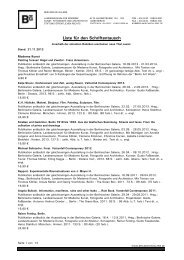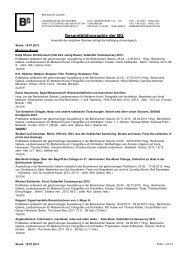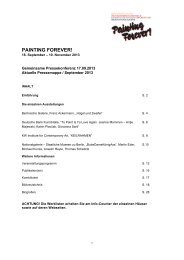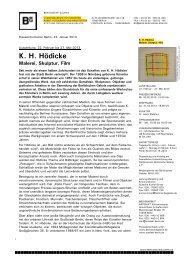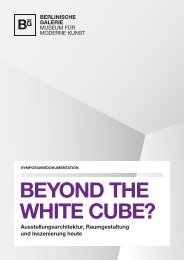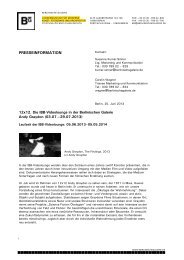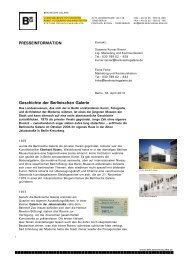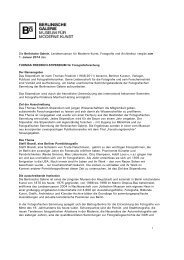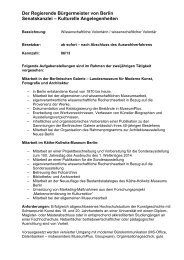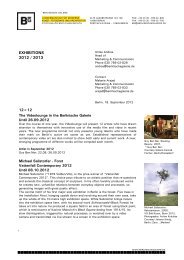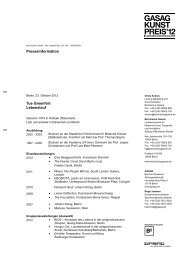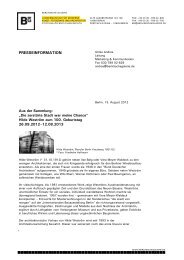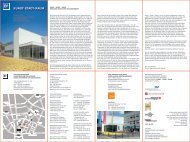Handout zur Ausstellung - Berlinische Galerie
Handout zur Ausstellung - Berlinische Galerie
Handout zur Ausstellung - Berlinische Galerie
Sie wollen auch ein ePaper? Erhöhen Sie die Reichweite Ihrer Titel.
YUMPU macht aus Druck-PDFs automatisch weboptimierte ePaper, die Google liebt.
Der Kubismus mit seiner Auflösung des traditionellen<br />
Bildraums durch simultane Perspektiven führt<br />
Henning Bohl zu seinen rot-grünen 3D-Darstellungen.<br />
Die Aufsplitterung des traditionellen Bildraums, die in<br />
der klassischen Moderne begann, verbindet er mit der<br />
Erweiterung des Bildraums in die dritte Dimension,<br />
wie sie erstmals in den 1950er Jahren durch rot-grüne<br />
3D-Darstellungen versucht wurde. Zur Erzeugung<br />
eines räumlichen Eindrucks müssen hierfür zwei<br />
Bilder aus je unterschiedlichen Perspektiven bzw.<br />
Positionen aufgenommen werden. Die Arbeit Anni 3<br />
scheint diesen Effekt hervorrufen zu wollen. Die<br />
Vorlage für das Motiv fand Henning Bohl in einer<br />
<strong>Ausstellung</strong> mit privaten Fotos von Joseph Albers, der<br />
1923 seine Frau Anni Albers auf dem Sofa liegend aus<br />
zwei minimal veränderten Perspektiven fotografierte<br />
und beide Fotos als Collage nebeneinander auf einen<br />
Karton klebte.<br />
Aus solchen angeeigneten Fundstücken,<br />
Anspielungen und Verweisen entstehen schließlich<br />
vielschichtige Bildwelten, die Henning Bohl den<br />
Erklärungsmustern der Besucher überlässt. Die<br />
individuelle Art des Verstehen und Nichtverstehen<br />
dieser Bezüge schließlich entscheidet über die<br />
Erschließung, Richtung und Komplexität möglicher<br />
neuer Konstruktionen von Bedeutung und Sinn.<br />
Henning Bohl ist 1975 in Oldenburg geboren. Von<br />
1997-2000 studierte an der Kunsthochschule Kassel<br />
und von 2000-2004 bei Thomas Bayrle an die<br />
Städelschule in Frankfurt am Main.<br />
Works by Henning Bohl rarely stand alone. They are<br />
usually clustered around a common theme to create<br />
arrangements. Literary snippets and extracts from<br />
artistic biographies are so inextricably combined with<br />
stylistic quotes and cited motifs that they are hard to<br />
disentangle. To this inexhaustible reservoir of existing<br />
forms Henning Bohl adds that minimal touch of his<br />
own, generating new, surprising elements and<br />
consciously defying any overhasty decoding or clearcut<br />
attributions.<br />
The paintings, collages and staged objects in this<br />
exhibition were made between 2003 and 2006. They<br />
constitute a body of work that has been held in the<br />
<strong>Berlinische</strong> <strong>Galerie</strong> collection since 2011 and is now<br />
being shown for the first time in this form, conceived<br />
together with the artist.<br />
The basic material is the modern age itself and its<br />
efforts to merge life with art. Experiments with the<br />
silhouette as a medium recall Matisse, but there are<br />
also hints here of Japanese Kabuki theatre with its<br />
expressive devices and design elements. In Toward a<br />
Coffee Table Book, a Mike Kelley edition of the<br />
magazine “Texte <strong>zur</strong> Kunst” prompts him to include<br />
triangular Ikea tables, and in the exhibition space<br />
these become Constructivist partitions. The work<br />
Kubistische Tagesdecke 5 revolves around a<br />
patchwork quilt sewn by Sonia Delaunay for her baby<br />
son in 1911 and now in the Centre Pompidou in Paris.<br />
The quilt was partly reminiscent of the patchworks<br />
handcrafted by Ukrainian peasant women in her<br />
birthplace, but it can also be read as a Cubist picture.<br />
Henning Bohl’s “counterpane pictures” make similar<br />
use of leftovers. Fragments of paper lying around the<br />
studio were turned into jigsaw images, and again the<br />
technique is a reference to Matisse and his<br />
silhouettes.<br />
Cubism, which dissolves the traditional picture space<br />
and replaces it with simultaneous perspectives, is the<br />
trigger for Henning Bohl’s red-and-green 3D works.<br />
Onto this fragmentation of space initiated by classical<br />
modernism he tacks an extension of the picture space<br />
into the third dimension, first tried in the 1950s with<br />
red-and-green 3D images. To create an impression of<br />
depth, two pictures must be taken from different<br />
perspectives or positions. That is the effect apparently<br />
sought by the work Anni 3. Henning Bohl found the<br />
original for this motif in an exhibition of private photos<br />
by Joseph Albers, who in 1923 photographed his wife<br />
Anni Albers lying on the sofa from two slightly altered<br />
perspectives and then stuck the pictures next to each<br />
other on card as in collage.<br />
Out of these found fragments, references and<br />
allusions, Henning Bohl forges multi-layered visual<br />
worlds, but he leaves it to his visitors to apply<br />
explanatory models of their own to make “sense” of<br />
them. The personal ways in which we understand or<br />
fail to understand these references ultimately<br />
determines how we unlock potential new<br />
constructions of meaning, the directions we pursue<br />
and the complexity we take on board.<br />
Henning Bohl was born in Oldenburg in 1975. From<br />
1997 to 2000 he studied at the Kunsthochschule in<br />
Kassel and from 2000 to 2004 under Thomas Bayrle at<br />
the Städelschule in Frankfurt am Main.<br />
BERLINISCHE GALERIE<br />
LANDESMUSEUM FÜR MODERNE KUNST, FOTOGRAFIE UND ARCHITEKTUR<br />
Alte Jakobstraße 124–128, 10969 Berlin, Mi–Mo 10–18h, www.berlinischegalerie.de



